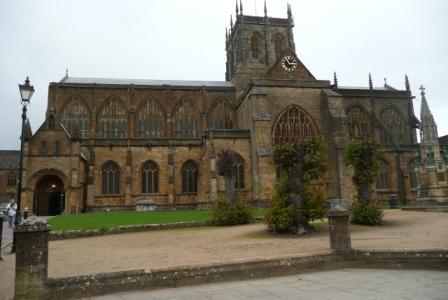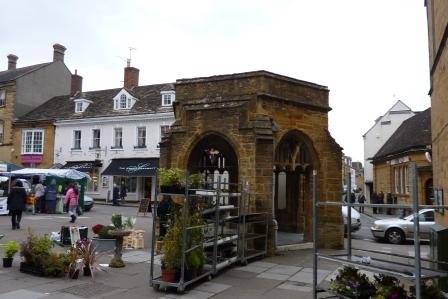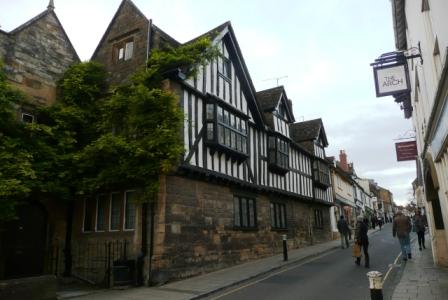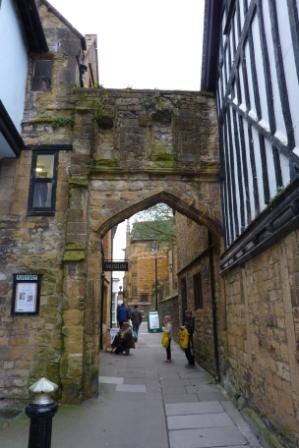| Early Kellaway Line Sherborne | Later Kellaway Families |
| The Abbey | The Conduit House | Cheap Street | The Museum |
|---|---|---|---|
 |
 |
 |
 |
| Sherborne 2012 | |||
THE SHERBORNE PAGE |
|
Sherborne is a beautiful small town in Dorset close to the Somerset border. It is the home of one of the oldest medieval Kellaway lines who were prominent there in the C15.
The town dates back to Saxon times and the Abbey is built on the site of the once Saxon Cathedral of which St Aldhelm was the first Bishop in 705AD. The see included Dorset, Somerset, Devon and Cornwall and lasted for 200 years until 909 when it was sub-divided by the creation of the see of Wells (for Somerset) and Credition (for Devon and Cornwall). In 1058 it was joined to the see of Ramsbury under Bishop Herman, the last Bishop of Sherborne. In 1075, after the Norman Conquest, the Bishop′s seat was moved to Old Sarum (Old Salisbury) and the Cathedral became the church of the Benedictine Monestry. There are some fine medieval and Tudor buildings to see in the town centre such as the Abbey, the Almshouses, the Conduit House (originally the monk′s lavatorium), the Julian (originally an inn), Sherborne School, the Old Castle and the New Castle. |
| Early Kellaway Line Sherborne | Later Kellaway Families |
| The Abbey | The Conduit House | Cheap Street | The Museum |
|---|---|---|---|
 |
 |
 |
 |
| Sherborne 2012 | |||
|
The nave of the Abbey church at Sherborne, dedicated to St. Mary, was for many years used as the parish church of the town, while the monks kept the east end of the church for their own use. However, during rebuilding work at the end of C14 a large new church dedicated to All Hallows was added to the west end of the Abbey as a chapel-of-ease for the townsfolk. This arrangement led to trouble during the early C15. By 1437 all parish services were held in the new All Hallows Church except baptisms which were conducted at the font in the Abbey nave. Because All Hallows was a chapel-of-ease, it was not legally entitled to a font of its own. This continued until the monks, during their reconstruction of the abbey, moved the font from its usual position in the nave, and narrowed the doorway giving access to the nave from All Hallows. The townspeople built their own font in All Hallows.
Abbot Bradford, rector of Sherborne Abbey, complained to Bishop Nevill that the parishioners had built an illegal font in All Hallows ‘contrary to our prohibition concerning the matter.’ The monks were also complaining that the parishioners were ringing the bells of All Hallows very early in the morning disturbing their sleep after their long night offices. Tensions continued to increase with the parishioners complaining about the moving of the font and the narrowing of the doorway leading into All Hallows. The baptismal procession had to pass through this door from All Hallows to go to the font. There were confrontations between the monks and parishioners during baptismal processions at Easter and Pentecost in 1436. Robert Nevill, Bishop of Salisbury, under whose jurisdiction Sherborne lay, held an inquiry at Sherborne on 12 November 1436 in an attempt to reconcile the dispute. John Baret, co-founder of the Almshouse, John Kayleway of Sherborne, one of the trustees of the 1419 Almshouse, Richard Rochell the accountant, and John Spadard, another of the Almshouse brethren are mentioned by name as having been specially summoned to attend the inquiry. All these men were no doubt well-known and respected by everyone in Sherborne. The Bishop hoped they would represent more sober judgment in resolving the problem. They apparently responded with a conservative approach, still taking the side of the parishioners – that the monks had arbitrarily disrupted their baptismal processions by moving the font and obstructing the door to the nave. Six weeks after the hearing Bishop Nevill issued an ordinance which he hoped would resolve the issues. He ordered the illegal font in All Hallows to be destroyed and removed, and the bells of All Hallows not to ring before 6 a.m., except on the four great feasts of the year. He ordered the monks to move the abbey font back to its ancient position and to widen the door they had narrowed. Finally, the monks were to build a wall or partition at the expense of the monastery, so that there should be a distinct separation between the monks and parishioners. He gave the monks until the following Christmas (almost a year) to carry out these orders. The orders were never carried out except for the building of the partition. The dispute simmered through the spring and summer of 1437, and boiled over after the Abbot sent William Gallor, a ‘stout butcher”, to smash the new All Hallows font. Many of the prominent men of the town were on the side of the parishoners. John Kayleway who had appeared at Bishop Nevill′s hearing was one of them, and perhaps his son, William Kayleway. John Baret of Lodborne (South Street) who would be one of the founders of the almshouse to soon be built under the Royal license of July 1437, was another. Infuriated by the destruction of the new font, the townspeople retaliated, and on the night of 28 October 1437 one of their priests, Richard Vowells, fired an arrow with a burning tip into the temporary thatch roof of the new abbey, causing a huge fire from the burning roof and much damage to the new construction, even melting the lead roof of the tower and the bells. In the end, the Pope was needed to settle the conflict and the townspeople were forced to contribute to the repairs of St. Mary′s Church which they had destroyed. The beautiful new abbey church, St.Mary′s, was finally rebuilt but the parishioners continued to use All Hallows as their parish church. This arrangement continued until the dissolution of the monastaries in 1538. After this St. Mary′s church became the parish church of Sherborne. All Hallows Church was torn down soon after the surrender of Sherborne Abbey in 1539. St. Mary′s Church underwent some restoration and remodeling during Victorian times, between 1856 and 1858. All the medieval stained glass (mostly C15), which was formally in the clerestory windows of the choir was removed from the church and was stored at the Victoria and Albert Museum in London until about 1925 when it was brought together and installed in St. Katherine′s chapel of the church. One of the pieces of glass is a quartering of the Kellaway coat of arms. This version of the arms includes a mullet (star) which is a cadency mark indicating it was the arms of a third son. It is almost certainly the arms of Thomas Kellaway the third son of William Kellaway and Joan Barret. Thomas was his father′s heir. The new positioning of the coat of arms is fortuitous since Thomas Kellaway married a daughter of Leweston (names not recorded) about 1500 and St. Katherine′s chapel is home to the fine Elizabethan alter-tomb which commemorates John Leweston and his wife Joan, 1584, the last of their line.
The links between the Abbey and the Kellaways can be seen from these records. In his Will of 1469 William Kayleway son of John Kayleway made the following bequests to the church and Abbey: All Hallows churchwarden′s accounts; 1512-13 Recorded that John Kellway received 2 d. “for crying off Saynt Mary pardon” on Easter Eve. A similar entry appears in most of the accounts, and “the Pardon” appears to have been cried in the streets. The church raised funds in numerous ways. One way was to loan out church house accessories for a fee. Thus, in the 1522-23 account “Master Keyleway for 4d. hired the loan of the best cope.” The All Hallows account of Thomas Fry, 1523-24, has an entry “recevyd off Master Robert Kelwey for his grandfaders be quest vj s. viij d.”(6s 8d) | |||||||||
|
The first almshouse at Sherborne existed in 1223, Brother John′s almshouse, but little is known about it.
William Dodill′s almshouse was established at Sherborne in 1406. It was the second such home for the destitute and sick citizens of the parish. William Dodill by his charter of 1406 gave a messuage or dwelling house in Hound Street tithing for the use of the poor. John Keylewey became a trustee of this almshouse in 1419 to replace a trustee who had died. Nineteen new trustees were appointed at this time, including John Barrett, later one of the Founders of a new almshouse, and whose granddaughter Joan married William Keylewey John′s grandson. By the mid 1430s larger and better premises were needed so the new Sherborne almshouse was started by the old trustees of Dodill′s almshouse. In 1436/7 a Royal charter was issued by King Henry VI to the Foundation, and this became the first fully licensed corporation in Sherborne.
The almshouse was supported by gifts of properties, lands and livestock given by local people. The profits from leases plus crops and livestock went to the trustees to be used in support of the almshouse and its inmates. Just before the Royal Charter was granted, a collection was taken from the citizens of Sherborne to begin a building fund. A list of contributors to the building fund survives in the accounts of Richard Rochelle, 1437-8, which Mayo in his “Historic Guide to the Almshouse, Sherborne” describes as “practically a directory of the inhabitants of Sherborne.” These are some from the list including Kellaways and others who have some link to the Kellaways: Another list for three-quarters of the year from Michaelmas to the Morrow of St John Baptist, 1438-9, Richard Rochell′s account, has “gifts of non-parishioners, next follows on this roll:” The records of the Almshouse have survived, most written in Latin for the early years. They are on deposit at the Dorset Record Office in Dorchester. There are a few interesting entries concerning the connection of the Kellaways, and some allied families, in these records. Some played important roles in founding the almshouse. The accountants, Richard Rochell and John Dene, soon to be titled “Keepers and governors of the Almshouse,” kept the records. An interim account of 1437/38, which included the closing of the old Dodill′s account and beginning the new account, has some interesting entries: The almshouse was to provide shelter for 12 men and 4 women. The Foundation Deed was far more than a transfer of property. It included in great detail the rules by which the inmates were to live. Their religious duties and services were given particular attention. Quoting from Canon Mayo′s “A Historic Guide to the Almshouse,” the following entries are of interest. “Also that every of the saide sixteen pore men and wymmen and every of there successors for evermore shal dayly by there power hear one messe [mass] and to worship of god of the seyntes of seynt John Baptist and seynt John Evangelist and for the sane estate of the saide Kyng Herry the sixt and for the sane estate of me the saide Bysshop my mooder brethers sisters auncestors kynne and successors and for the goode and sane estate of the saide Humphrey [Stafford] and children and of John my brother nowe by the grace of god Bysshop of Bathe and Chauncellor of Yngelond and of al myne auncestors and kynne and of me the saide Margarete [Gough] and of al my kynne and of us the saide John Fauntleroy and John Baret of oure wyfes children and kynne and of William Kayleway of Shirbourne aforesaid and for the good estate of the saide twenty brethers and of there successors of there wyfes childryn and kynne and for the goode estate of all those that geveth byquethe speketh or doeth or hath geve byquethe spoken or do eny goode to the saide house whyles we all and thay shall leve yn this present worle and for the saide Kynge his soule and for all his progenyatours and for myne the saide Bysshop of Salesbury my moder brethers sisters auncesters kynne and successors soules and for myne the said Humfray [Stafford] childryn and brother and kynne his soules and for myn the saide Margarete [Gough] and al my kynne his soules and for oures the saide John Fauntleroy and John Baret and all oure wifes childryn brethers and kyne his soules. And for the saide William Kaylway and al his kynne his soules the whiche William hath be most special laborer to gete the saide letters patentes of oure soverayn lorde the Kyng and also of makying of this present fundacion and for the twenty saide brethers and there successors wyfs childryn and kynne his soules and for all the saide good doers soules to the saide house when they and we shall passe oute of this present worlde. And for the soules of Elizabeth sum tyme the wife of Humfray some tyme the fader and Alice sum tyme the moder of the saide Humfray Stafford and for the soules of the husband fader and moder that sum tyme was the saide Margaret Gogh is and of the soules of John Campedene sum tyme vicar of the saide towne of Shirbourne al so for the soules of Richard Fyton Henry Panter Symond Chamberleyn Athomas Peytevyn Elizabeth Climyng [or Clunyng] Nicol Rake of there wyfes husbond childryn brethers and kynne and for the soule of Isabelle that sum tyme was the wyfe of the saide William Kayleway and for al Cristen soules shall praye and saye by there power dayly foure tymes oure Lady sauter when and where hit shal lyke them,” etc. The Foundation deed ends as follows: Bygunne made founded gadered and stablisshet the tenthe day of the monthe of Januarye the yere of the regnyng of the saide Kyng Herry the sixte after the conquest the sixtynth (1437/8).” As early as 1443/4 a ‘Fraternity of the House’ existed, apparently a religious Guild. A number of people gave money to be admitted to the Fraternity. In the heading of their account for 1446/7, soon after the chapel of the almshouse had been consecrated, Richard Rochelle and John Keylewey refer to themselves as “Masters of the Brethren and Sisters of the Guild of the Almshouse, Shirborne” [Magistri Fratrum et Sororum Gulde domus Elemosinarum Shirborn′], according to Fowler. In his Will of 1469 William Kayleway son of John Kayleway made the following bequest to the Almshouses: The Almshouse is of course a listed building described in the listing as follows: | |||||||||
| Early Kellaway Line Sherborne | Later Kellaway Families |
Back to Notes and Stories Index